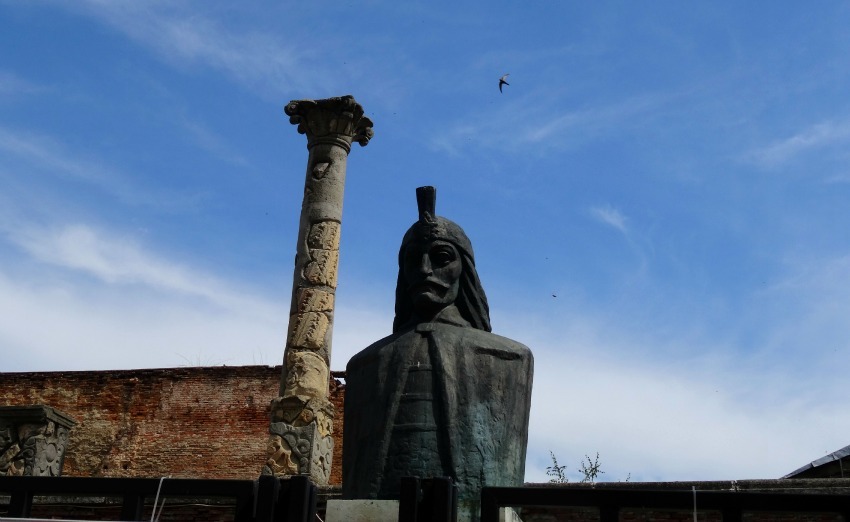We have all read the classic or watched one of the many films on Dracula. But have you ever wanted to know more? Who is this man of mystery? Charming ancient soul during the day and vampire in search of blood at night. To tell the truth, Dracula is a factious character created by Bram Stoker. But there was a lot of inspiration for its dark and attractive story. Come with me while I hunt Dracula in Romania.
“I want you to believe … believe in things you can’t.” ~ de Dracula by Bram Stoker
Vlad vs Dracula
There were two main inspirations for Dracula de Stoker. The first and best known is Vlad Tepes Dracula. Vlad was a Romanian prince of Wallachia, not Transylvania, in the 15th century, and is famous for his impact of these enemies. The truth is that he was not a villain, he only killed to protect his country and his people. He was not a vampire, but his name, Dracul, translates directly by Devil. It was perhaps a combination of the fulllage and the curious name that struck Stoker. Even Bran’s castle, the inspiration for Dracula’s castle has never been that of Vlad. It is said that Bram Stoker simply saw a photo of it and used it loosely like its inspiration.
THE “Real” Vampire?
Curiously, a great inspiration for the stoker vampire was a woman. The Hungarian countess Elizabeth Bathory is known as one of the most prolific serial killers in history. At the end of the 16th century and at the beginning of the 17th century, she would kill young virgins, would drain them with their blood and made them take advantage of to reach eternal youth. She would even have drank their blood. It is certainly more similar to vampires than Vlad.
The Strigoi
The Strigoi could also play a role in evoking the character of Dracula. Romanian mythology says that Strigoi are troubled souls from the dead, which rise from the grave. It is not only an old forgotten myth. He always presents himself to modern Romania. A few years ago, he even made a new one when a group of villagers dug a body and cut his heart, burned it and then drank it. They thought it would heal them as well as their nightmare village they had concerning the dead. They believed that he had become a Strigoi and haunted their dreams.
My hunting in Dracula
Last summer, while traveling through Europe, I was impatient to explore a little Romania. And I must admit that Dracula, his myth and the legend of Vlad, were all part of my choice to visit Romania. My base was Bucharest for five days.
The first time I had Vlad’s wind was when I saw his bust seeming to look at me over a brick wall while I was passing the old princely courtyard. Built by Vlad during the last part of the 15th century as a fortress, it is now in ruins. A walk in the park, alone, and down in its basement gave off the air of goosebumps. All alone in the corners of the ruins, I couldn’t help but feel like I was in a dark cave. Coming in the air, I passed in front of old tombstones and I took a short staircase to a patio on the apparently medieval roof. In the old town of Bucharest, it may have been an ideal place to build its fortress, now it seemed to go unnoticed by the inhabitants and the few tourists who pass.
The next day, I made the two castles in a one -day tour. The tour took a group of five, strangely all women, as well as a guide on the mountains of carpathians in Romania with two castles. One of them was Bran Castle. We stopped for a traditional Romanian lunch overlooking the castle and a striking white statue of Vlad Tepes on horseback. Surrounded by lush green mountains that were wrapped in a heavy fog, everything set the mood for our visit to the famous site.
Built as a fortress in the 13th century on the border between Transylvania and Wallachia. Bran Castle has no real link with Vlad Tepes, except that he was briefly imprisoned there. The real castle of Vlad, Castle Poenari, is located further west. But Bran Castle was made famous when Bram Stoker used it as his inspiration for Dracula Castle on the hill. This modest fortress is small compared to many others. Housing small pieces, narrow corridors and stairs, and a richness of interesting vintage furniture from the royal family of Romania. He also has an exhibition on medieval torture instruments. Perhaps a nod to Vlad the impaler himself.
It was perhaps not the castle of Vlad, it was symbolically that of Dracula. And standing at the top, looking at the surroundings, it is not surprising that people flocked here. The fortress had a feeling of charm intertwined with unhappiness. Surrounded by the glorious mountains, with their air of mystery, and near Transylvania, everything was so strange and surreal.
I may not have seen Dracula or any other vampires, but there is no doubt that his myth has a strong presence throughout Romania. And while I got closer to the persistent ghost of Vlad, its energy will be hidden forever in the hearts of the inhabitants and will inspire tourists to visit this incredible country.
Other sites to visit:
- Castle Poenari – The castle of Vlad Tepes, located 2.5 hours northwest of Bucharest
- Sougisoaara – Vlad tepes place of birth, located 5 a.m. north of Bucharest, where you can visit his house
- Snagov – island monastery, located 1 hour north of Bucharest, possible site of the Vlad burial
- Comana monastery – Original monastery founded and built by Vlad Tepes, located 1 hour south of Bucharest, possible site of the Vlad burial
Have you ever traveled in search of a fictitious character?
Pin this image for later!










